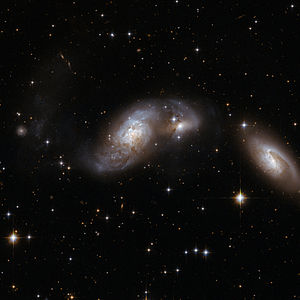IC 4686
| Galaxie IC 4686 | |
|---|---|
 | |
| Die Galaxien IC 4687 (Mitte), IC 4686 (rechts der Mitte) und IC 4689 (am rechten Bildrand) aufgenommen vom Hubble-Weltraumteleskop | |
| AladinLite | |
| Sternbild | Pfau |
| Position Äquinoktium: J2000.0, Epoche: J2000.0 | |
| Rektaszension | 18h 13m 38,6s[1] |
| Deklination | -57° 43′ 57″[1] |
| Erscheinungsbild | |
| Morphologischer Typ | S? pec HII[1] |
| Helligkeit (visuell) | 13,9 mag[2] |
| Helligkeit (B-Band) | 14,7 mag[2] |
| Winkelausdehnung | 0,6′ × 0,5′[2] |
| Positionswinkel | 125°[2] |
| Flächenhelligkeit | 12,4 mag/arcmin²[2] |
| Physikalische Daten | |
| Zugehörigkeit | LGG 418[3] |
| Rotverschiebung | 0.016505 ± 0.000043[1] |
| Radialgeschwindigkeit | (4948 ± 13) km/s[1] |
| Hubbledistanz vrad / H0 | (218 ± 15) · 106 Lj (66,7 ± 4,7) Mpc [1] |
| Geschichte | |
| Entdeckung | Royal Harwood Frost |
| Entdeckungsdatum | 1. August 1904 |
| Katalogbezeichnungen | |
| IC 4686 • PGC 61601 • ESO 140-09 • 2MASX J18133883-5743572 • SGC 180919-5744.8 • FAIR 44 | |
IC 4686 ist eine Spiralgalaxie vom Hubble-Typ S im Sternbild Pfau am Südsternhimmel. Sie ist rund 218 Millionen Lichtjahre von der Milchstraße entfernt und hat einen Durchmesser, einschließlich des von IC 4687 verdeckten Bereichs, von etwa 35.000 Lichtjahren.
IC 4686 bildet zusammen mit IC 4687 und IC 4689 ein wechselwirkendes Galaxientrio.
Die Galaxie IC 4686 wurde am 1. August 1904 von dem US-amerikanischen Astronomen Royal Harwood Frost entdeckt[4].
Weblinks
Einzelnachweise
Auf dieser Seite verwendete Medien
IC 4687 forms a triplet with two other galaxies: IC 4686 to the right and IC 4689 further to the right. IC 4687 has a chaotic body of stars, gas and dust and a large curly tail to the left. The two companions are partially obscured by dark bands of dust. The interacting triplet is about 250 million light-years away from Earth, in the constellation of Pavo, the Peacock.
This image is part of a large collection of 59 images of merging galaxies taken by the Hubble Space Telescope and released on the occasion of its 18th anniversary on 24th April 2008.
| About the object | |
|---|---|
| Object name | IC 4687, IC 4689, IC 4687/6, AM 1809-574 |
| Object description | Interacting Galaxies |
| Position (J2000) | 18 13 39.98 -57 43 31.0 |
| Constellation | Pavo |
| Distance | 250 million light-years (50 million parsecs) |
| About the data | |
| Data description | The Hubble image was created using HST data from proposal 10592: A. Evans (University of Virginia, Charlottesville/NRAO/Stony Brook University) |
| Instrument | ACS/WFC |
| Exposure date(s) | April 7, 2002 |
| Exposure time | 38 minutes |
| Filters | F435W (B) and F814W (I) |



